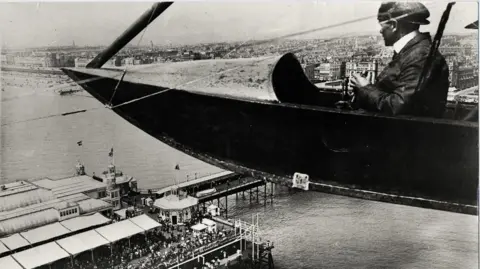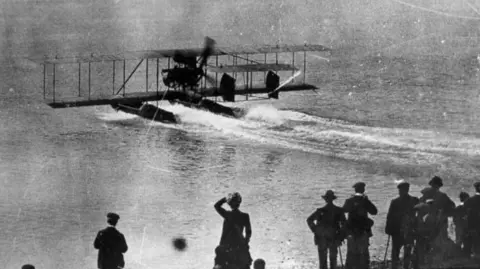The brothers who built seaplanes in a city centre
 Ian Gledhill
Ian GledhillSome of the earliest seaplanes were built in Brighton city centre, carried down to the beach and launched into the sea.
Pioneering engineer George Herbert Volk (known as Bert) had a workshop in the North Laine district of the city.
In 1911, he started making parts for engines, wings, floats, and fabric bodies that would be fitted into planes, and two years later pleasure flights began being launched.
Historian Ian Gledhill said: "The fact the city was very much involved in early aviation was an important piece of Brighton history and something to be proud of."
Bert Volk's elder brother, Herman, invented a collapsible, portable hanger on the edge of the water from where pleasure flights started.
The family are best known for the tourist railway which still runs along Brighton seafront, pioneered by the brothers' father Magnus.
Bert Volk started life as an engineer making cars in 1910.
A year later the first airplane landed in Brighton on the beach, a Bleriot monoplane.
Mr Gledhill said: "Volk became fascinated with aviation and he thought he would have a go.
"They were all built in bits and taken down to the seafront next to the Banjo Groyne, put together and launched into the sea."
His brother Herman created the hanger, Volk's Seaplane Station, on the seafront.
There was a ramp down into the water and planes were launched into the sea.
 Ian Gledhill
Ian GledhillA year after flights started, the outbreak of World War One meant the hanger was requisitioned by the government and the project ended.
Herman Volk went off to manufacture planes for the war effort.
He also contributed to the development of Shoreham Airport - one of the first aerodromes in England.
After the war he took over the running of Volk's Electric Railway on the seafront.
Bert went off to South Africa where he spent most of the rest of his life.
So what was the legacy of the Volk brothers in the early years of aviation?
Mr Gledhill said: "Seaplanes played a big part during World War One and that's what Herman and Bert Volk contributed to.
"So we have to be extremely grateful to them for that."
Follow BBC Sussex on Facebook, on X, and on Instagram. Send your story ideas to [email protected] or WhatsApp us on 08081 002250.
